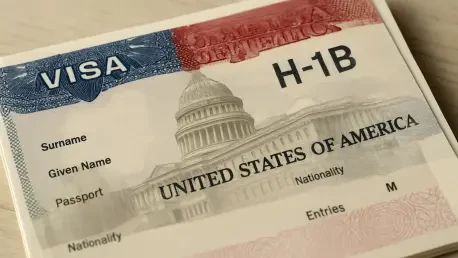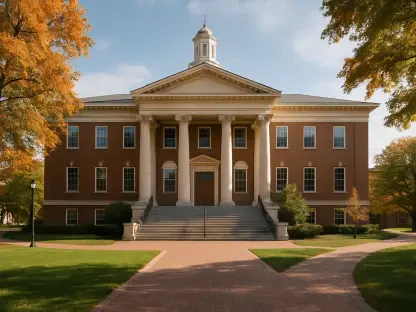In a stunning turn of policy, a staggering $100,000 fee for new H-1B visa petitions has emerged as a seismic shift that could fundamentally alter the landscape of higher education in the United States, challenging the ability of academic institutions to attract top international talent. This dramatic increase, introduced through a presidential proclamation on September 19, stands in stark contrast to the previous fee range of $2,000 to $5,000, as documented by the American Immigration Council. For academic institutions, which have long relied on the H-1B program to attract top international talent, this change poses an unprecedented challenge to maintaining global competitiveness. The significance of this trend extends beyond mere cost, touching on the very fabric of diversity, innovation, and research capacity in universities. This analysis delves into the policy’s implications, financial and logistical burdens, expert opinions, future outlook, and practical steps for institutions navigating this new reality.
Understanding the $100,000 H-1B Visa Fee Policy
Policy Overview and Key Details
The presidential proclamation of September 19 marked a radical departure from prior H-1B visa fee structures, escalating the cost to $100,000 for new petitions. This is a sharp rise from the earlier range of $2,000 to $5,000, creating a financial barrier that few anticipated. According to data from the American Immigration Council, this policy shift targets initial petitions for workers entering from outside the U.S., fundamentally altering the economics of international hiring.
Further clarity from U.S. Citizenship and Immigration Services (USCIS) indicates that the fee applies as a one-time charge for new entrants, with exemptions for those already in the country transitioning status, such as from an F-1 student visa to H-1B. This distinction offers some relief but still leaves significant hurdles for recruiting talent directly from abroad. The policy’s narrow scope of exemptions, tied to stringent national interest criteria, adds another layer of complexity for institutions seeking waivers.
Immediate Consequences for Higher Education
Universities across the nation, particularly research-heavy ones like Stanford and Columbia, employ substantial numbers of H-1B workers, with each institution sponsoring over 200 such individuals in the current fiscal year. This reliance underscores the program’s critical role in filling specialized roles that drive academic progress. The new fee threatens to disrupt this dynamic, potentially leading to hiring freezes as budgets are strained.
Beyond mere numbers, the policy introduces real-world constraints, such as travel restrictions for international candidates who risk triggering the fee by leaving and re-entering the U.S. This limitation could deter prospective hires from considering positions at American institutions. Additionally, the reduced influx of diverse academic staff may impact the cultural and intellectual richness that international scholars bring to campuses, altering the educational environment for students.
Financial and Administrative Challenges for Institutions
Economic Strain on Diverse Campus Sizes
The financial burden of the $100,000 fee cuts across all types of higher education institutions, creating a universal challenge. Smaller colleges, often operating on tight budgets, find the cost prohibitive, effectively barring them from competing for global talent. Legal expert Joshua Wildes has pointed out that even larger universities, despite greater resources, hesitate to absorb such expenses due to the precedent it sets for future hiring.
This economic pressure may lead to reallocations within already constrained budgets, with potential cuts to research initiatives or educational programs. The ripple effect could compromise the quality of academic offerings, as funds are diverted to cover visa costs for a limited number of hires. Institutions face a dilemma between maintaining their commitment to global talent and preserving core academic priorities.
Logistical Barriers and Policy Ambiguity
Compounding the financial strain is the logistical confusion surrounding the policy’s rollout. Early speculation, fueled by comments from U.S. Commerce Secretary Howard Lutnick, suggested an annual fee, only for White House Press Secretary Karoline Leavitt to later confirm it as a one-time charge. This initial uncertainty has left colleges scrambling to interpret the rules and adjust their hiring strategies accordingly.
Further complications arise from travel limitations for candidates, who must avoid leaving the U.S. to prevent incurring the fee upon return. The Department of Homeland Security (DHS) has yet to provide clear criteria for exemptions, leaving institutions in a state of limbo as they attempt to navigate the hiring process. This ambiguity hinders long-term planning and exacerbates the administrative burden on already overstretched university offices.
Expert Insights and Sector-Wide Resistance
Views from Higher Education Leadership
Leaders in academia have voiced profound concern over the new fee’s impact on attracting international talent. Miriam Feldblum of the Presidents’ Alliance on Higher Education and Immigration has warned that the cost could deter top scholars and researchers, diminishing the expertise vital to American campuses. This perspective highlights a broader fear of losing ground in the global academic arena.
Similarly, Sarah Spreitzer from the American Council on Education (ACE) has criticized the policy as misaligned with national interests, arguing that H-1B workers are essential to economic and security priorities. The consensus among leaders points to potential setbacks in innovation, with fewer international hires possibly leading to reduced research output and limited course offerings. These warnings paint a grim picture of the policy’s unintended consequences on educational quality.
Advocacy Efforts and Legal Opposition
Resistance to the fee has galvanized the higher education sector, with over 30 organizations, spearheaded by ACE, urging DHS for a blanket exemption. Their argument rests on the indispensable contributions of H-1B workers to critical fields like medicine, science, and education, which benefit the nation as a whole. This collective push reflects a unified stand against what many see as a detrimental policy.
Legal challenges have also emerged, with the U.S. Chamber of Commerce and other groups filing lawsuits to contest the fee as an overreach of executive authority. These actions seek to block or overturn the policy, offering a glimmer of hope for institutions burdened by the cost. The outcome of these efforts remains uncertain, but they underscore the depth of opposition across multiple sectors impacted by the fee.
Future Implications and Broader Trends
Long-Term Effects on Academic Competitiveness
Looking ahead, the $100,000 fee could erode the U.S.’s standing as a leader in global education and research. By restricting access to a vital talent pipeline, universities may struggle to maintain their edge in cutting-edge fields, potentially ceding ground to competitors abroad. This trend threatens not just academia but also the nation’s broader innovation ecosystem.
Additionally, the policy fits into a larger pattern of tightening immigration pathways for skilled workers under the current administration. Such measures, aimed at protecting domestic jobs, may cumulatively weaken higher education by limiting the diversity and expertise that international hires bring. Over time, this could reshape the demographic and intellectual makeup of American campuses in profound ways.
Potential Scenarios and Adaptive Strategies
Several outcomes loom on the horizon, ranging from successful legal challenges that might nullify the fee to expanded exemptions that ease its burden. Conversely, a sustained policy could entrench hiring reductions, forcing universities to scale back ambitions for global recruitment. The uncertainty of these scenarios keeps institutions on edge as they await further developments.
In response, some colleges might pivot to alternative visa options like the O-1 for individuals with extraordinary abilities, though this path is not viable for early-career professionals. Others may prioritize domestic recruitment, despite the risk of narrowing the talent pool. Each strategy carries trade-offs, balancing short-term needs against the long-term goal of maintaining academic excellence in a competitive global landscape.
Conclusion and Call to Action
Summarizing the Core Challenges
Reflecting on the discourse, it becomes evident that the $100,000 H-1B visa fee poses severe financial and logistical obstacles for higher education institutions. The policy stands as a direct threat to academic excellence, risking the loss of international talent crucial for research and teaching. Unified resistance from the sector highlights a shared determination to challenge a measure seen as contrary to national economic and intellectual goals.
Pathways Forward for University Leaders
Looking ahead, the path forward demands proactive engagement from college administrators. Institutions are encouraged to seek exemptions for essential hires by crafting strong cases tied to national interest, leveraging legal support as needed. Exploring alternative visa categories, despite their limitations, offers a temporary workaround for some roles. Most crucially, sustained advocacy with policymakers emerges as a vital step to push for policy reversal, ensuring that academia retains its role as a beacon for global talent and innovation in the years to come.









